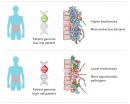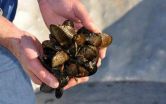(Press-News.org) ITHACA, N.Y. - In the fight against global warming, carbon capture - chemically trapping carbon dioxide before it releases into the atmosphere - is gaining momentum, but standard methods are plagued by toxicity, corrosiveness and inefficiency. Using a bag of chemistry tricks, Cornell materials scientists have invented low-toxicity, highly effective carbon-trapping "sponges" that could lead to increased use of the technology.
A research team led by Emmanuel Giannelis, the Walter R. Read Professor of Engineering in the Department of Materials Science and Engineering, has invented a powder that performs as well or better than industry benchmarks for carbon capture. A paper with their results, co-authored by postdoctoral associates Genggeng Qi and Liling Fu, appeared Dec. 12 in Nature Communications.
Used in natural gas and coal-burning plants, the most common carbon capture method today is called amine scrubbing, in which post-combustion, carbon dioxide-containing flue gas passes through liquid vats of amino compounds, or amines, which absorb most of the carbon dioxide. The carbon-rich gas is then pumped away - sequestered - or reused. The amine solution is extremely corrosive and requires capital-intensive containment.
The researchers have been working on a better, safer carbon-capture method since about 2008, and they have gone through several iterations. Their latest consists of a silica scaffold, the sorbent support, with nanoscale pores for maximum surface area. They dip the scaffold into liquid amine, which soaks into the support like a sponge and partially hardens. The finished product is a stable, dry white powder that captures carbon dioxide even in the presence of moisture.
Solid amine sorbents are used in carbon capture, Giannelis said, but the supports are usually only physically impregnated with the amines. Over time some of the amine is lost, decreasing effectiveness and increasing cost.
The researchers instead grew their amine onto the sorbent surface, which causes the amine to chemically bond to the sorbents, meaning very little amine loss over time.
Qi said the next steps are to optimize the sorbent and to eventually demonstrate it for industry, possibly at Cornell for retrofitting its power plant. He also said the technology could be used on smaller scale - for example, in greenhouses, where the captured carbon
INFORMATION:
The paper is called "Sponges With Covalently Tethered Amines for High-Efficiency Carbon Capture."
Cornell University has television, ISDN and dedicated Skype/Google+ Hangout studios available for media interviews.
HOUSTON -- (Dec. 16, 2014) -- In one of the most comprehensive laboratory studies of its kind, Rice University scientists traced the uptake and accumulation of quantum dot nanoparticles from water to plant roots, plant leaves and leaf-eating caterpillars.
The study, one of the first to examine how nanoparticles move through human-relevant food chains, found that nanoparticle accumulation in both plants and animals varied significantly depending upon the type of surface coating applied to the particles. The research is available online in the American Chemical Society's ...
This news release is available in German. A research team at Bielefeld University has succeeded in teaching the only robot of its kind in the world how to walk. Its first steps have been recorded in a video. You can watch them in Bielefeld University's latest posting on 'research_tv'. The robot is called Hector, and its construction is modelled on a stick insect. Inspired by the insect, Hector has passive elastic joints and an ultralight exoskeleton. What makes it unique is that it is also equipped with a great number of sensors and it functions according to a biologically ...
DURHAM, N.C. - Duke University scientists have developed new forensic tracers to identify coal ash contamination in water and distinguish it from contamination coming from other sources.
"These new tools can be used by federal and state regulatory agencies to monitor the environmental effects of coal ash and determine whether it has or hasn't impacted the environment," said Avner Vengosh, professor of geochemistry and water quality at Duke's Nicholas School of the Environment. "They can be used to trace the coal ash effluents to their source, even in watersheds where ...
Washington, D.C.--New work from Carnegie's Ivan Naumov and Russell Hemley delves into the chemistry underlying some surprising recent observations about hydrogen, and reveals remarkable parallels between hydrogen and graphene under extreme pressures. Their work is the cover story in the December issue of Accounts of Chemical Research.
Hydrogen is the most-abundant element in the cosmos. With only a single electron per atom, it is deceptively simple. As a result, hydrogen has been a testing ground for theories of the chemical bond since the birth of quantum mechanics ...
MINNEAPOLIS/ST. PAUL (12/16/2014)--A new study by an international team of researchers shows for the first time that people may inherit some of the intestinal bacteria that cause Crohn's disease and ulcerative colitis, collectively know as inflammatory bowel disease (IBD). The study, recently published in Genome Medicine, also confirmed that antibiotics could worsen the imbalance in the gut microbes.
About 1.6 million Americans suffer from Crohn's disease or ulcerative colitis, according to the Crohn's and Colitis Foundation of America. Understanding the causes of these ...
AMHERST, Mass. - In a follow-up to her earlier studies of learning in infancy, developmental psychologist Lisa Scott and colleagues at the University of Massachusetts Amherst are reporting that talking to babies in their first year, in particular naming things in their world, can help them make connections between what they see and hear, and these learning benefits can be seen as much as five years later.
"Learning in infancy between the ages of six to nine months lays a foundation for learning later in childhood," Scott says. "Infants learn labels for people and things ...
WASHINGTON, DC--December 16, 2014--Using mathematical modeling, researchers at New York and Vanderbilt universities have shown that commensal bacteria that cause problems later in life most likely played a key role in stabilizing early human populations. The finding, published in mBio®, the online open-access journal of the American Society for Microbiology, offers an explanation as to why humans co-evolved with microbes that can cause or contribute to cancer, inflammation, and degenerative diseases of aging.
The work sprung from a fundamental question in biology ...
INDIANAPOLIS -- In the first real-world trial of the impact of patient-controlled access to electronic medical records, almost half of the patients who participated withheld clinically sensitive information in their medical record from some or all of their health care providers.
Should patients control who can see specific information in their electronic medical records? How much control should they have? Can doctors and other clinicians provide safe, high-quality care when a patient's preference may deny members of the medical team from seeing portions of the electronic ...
BALTIMORE, MD (Dec. 16, 2014)--With a unique, multi-faceted approach, researchers at the Lieber Institute for Brain Development (LIBD) have quantified the effect of previously unidentified anomalies in genetic expression that determine how the human brain develops from its earliest stages. Their work, published online December 15th in Nature Neuroscience, offers a novel technique for identifying biological markers in brain development that associate with risk for neurodevelopmental disorders such as schizophrenia and autism spectrum disorder (ASD).
Using state-of-the-art ...
The mortality of larval Pacific oysters in Northwest hatcheries has been linked to ocean acidification. Yet the rate of increase in carbon dioxide in the atmosphere and the decrease of pH in near-shore waters have been questioned as being severe enough to cause the die-offs.
Now, a new study of Pacific oyster and Mediterranean mussel larvae found that the earliest larval stages are sensitive to saturation state, rather than carbon dioxide (CO2) or pH (acidity) per se.
Saturation state is a measure of how corrosive seawater is to the calcium carbonate shells made by ...






